I've recently received four lights from Streamlight for review, the Sidewinder, PolyTac 90, Night Com UV and Sidewinder Compact II.
This is the first review of this series of four Streamlight lights and I'm starting with a distinctive light that has been around since 2007 (and updated in 2009 to the C4 LED), the Sidewinder.
Designed as a replacement for the older incandescent fixed right-angle military lights, the Sidewinder offers much more and is still relevant today.
The Sidewinder itself has three different versions each providing slightly different characteristics to fine tune the output to the individual user's requirements. On test is the Sportsman version.
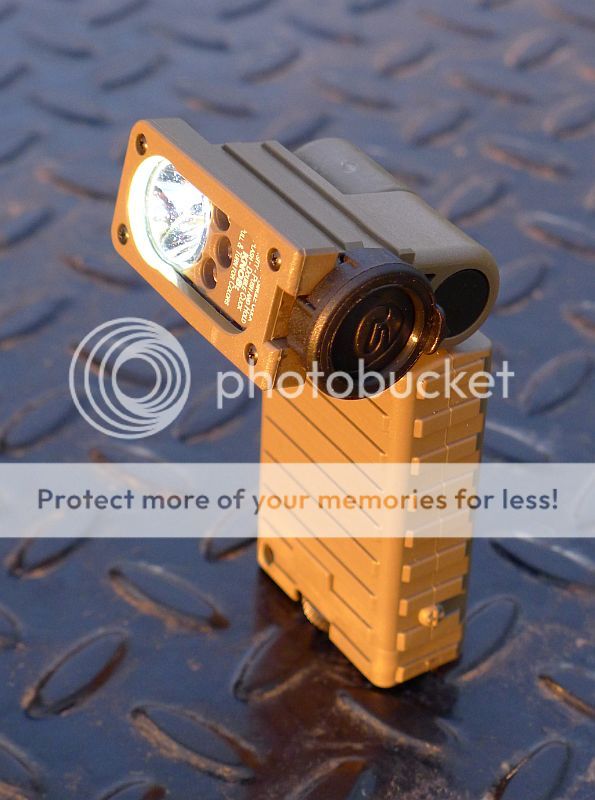
Initial Impressions:
The Sidewinder really is something a bit different. Love or hate its looks, call it ugly, industrial, or functional, but its design serves its function perfectly.
We are used to multiple emitters in lights these days, but usually to boost output; the Sidewinder uses four different emitters to give the user 20 different colour/brightness output options in one light.
Despite not looking ergonomically designed, the Sidewinder handles very well and is comfortable to use. Its adjustable angle head makes it possible to use the light in many different ways from a standard light to a MOLLE-mounted right-angle light.
What is in the box:
The Sidewinder comes in the blister-pack type of packaging.
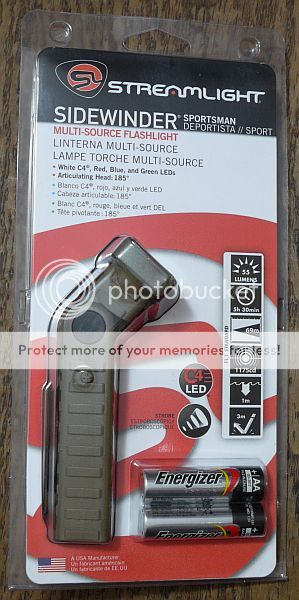
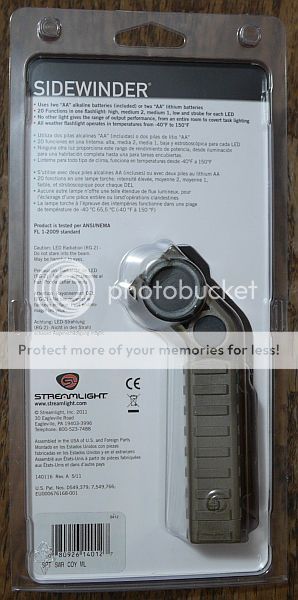
It is simply supplied with an instruction manual and two Energizer Alkaline AA batteries.
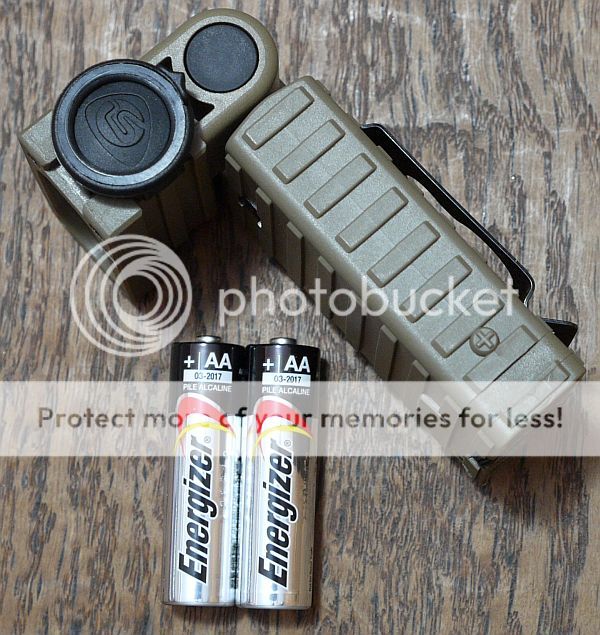
Taking a closer look and looking inside:
Viewed from the front, with the head set in the 90° position shows the Sidewinders polycarbonate lens and the four emitters.
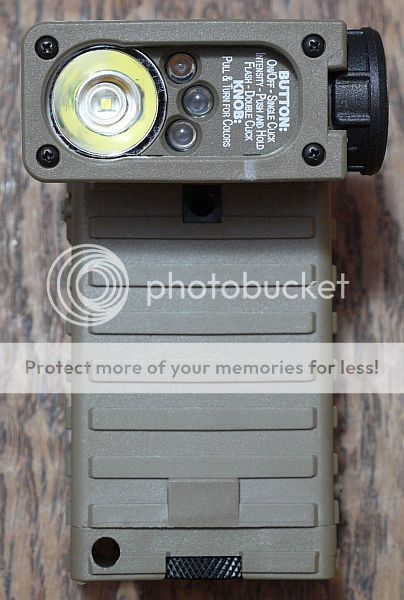
The head moves a total of 185° and is shown here straightened to make the Sidewinder more like a traditional light. Near to the head joint you can see the alternate fixing point for the clip. This allows you to choose which side to have the clip on depending on how you hold it and want to operate the switch.
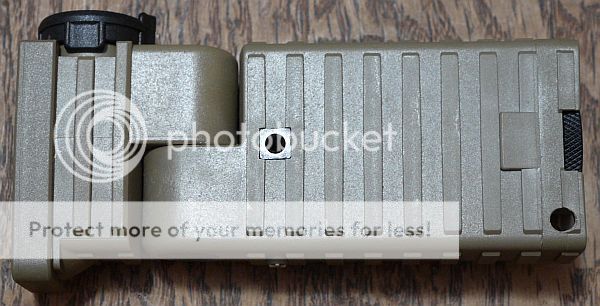
As supplied the clip position seems to suit right-handed users. The clip is sturdy, and made of coated steel. IT allows for belt, MOLLE, and with the ACH mount, helmet mounting options.
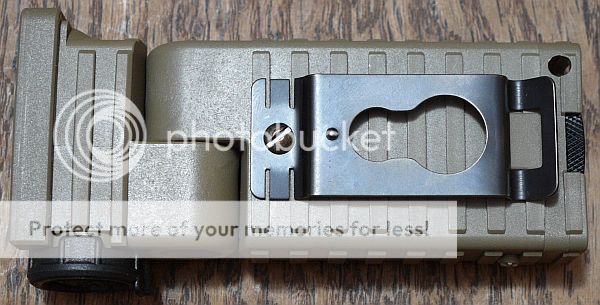
Looking more closely at the LEDs, the white emitter is Streamlight's C4 emitter (though C4 seems to cover many different LEDs) and the three standard 5mm coloured LEDs, red and blue either side of the green. The green LED is an infra-red LED on the military version.
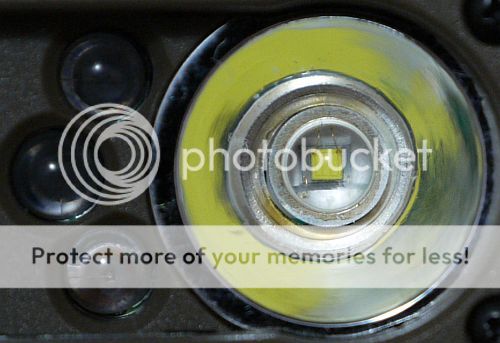
The tailcap is secured with a metal thumb screw and is flat, allowing tail-standing and it will tail-stand even with the head at 90°.
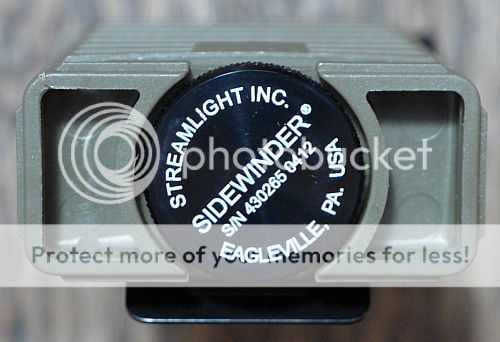
In line with its military design, the tailcap is captive, being secured by a metal wire tether.
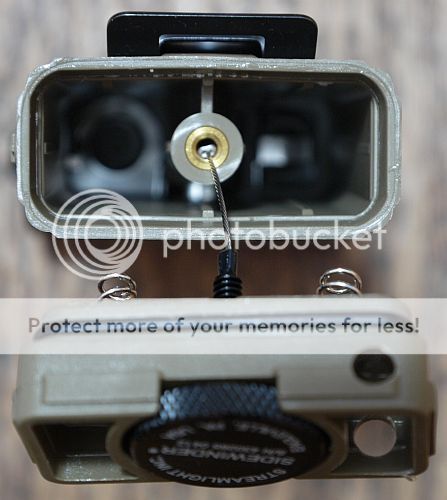
Looking down into the Sidewinder shows the contact design, which prevents problems caused by the batteries being inserted incorrectly. The Sidewinder case has tactile raised dots to indicate the positive battery terminal position, so you can change batteries in the dark, by feel alone.
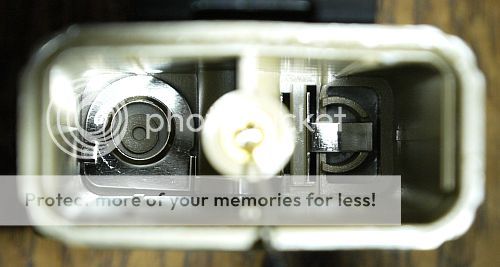
Shown with the white LED lit.
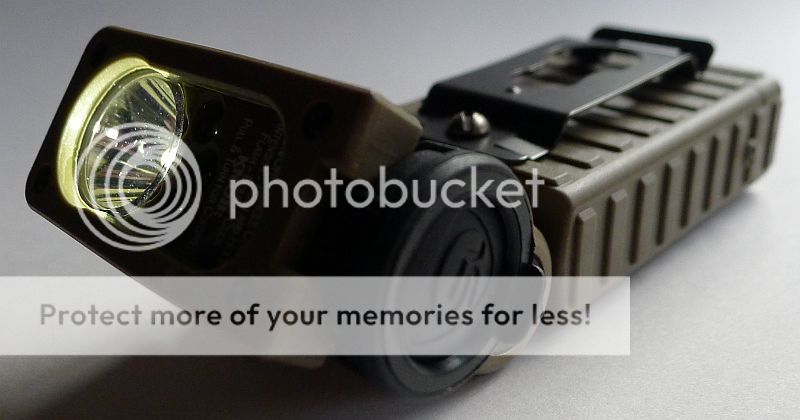
And here the raised positive terminal indicator can be seen on the top near the tail-cap.
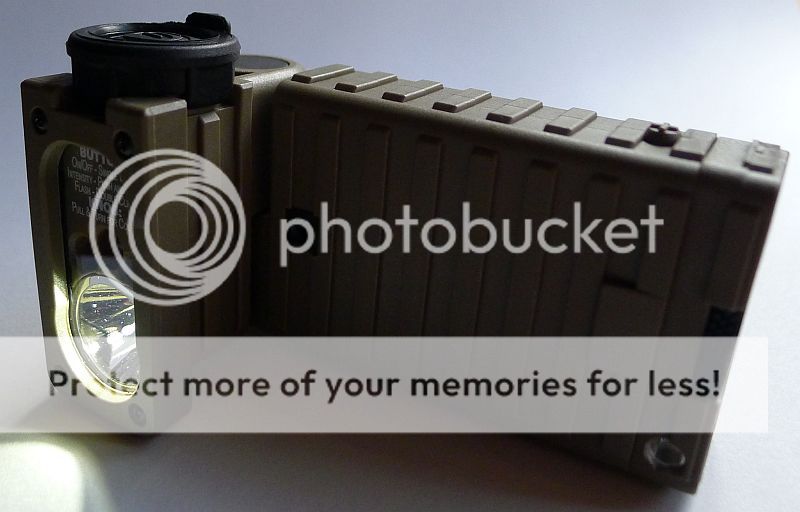
Modes and User Interface:
"20 flashlights in one" is one of the claims made for this light. This refers to the set of five modes which are repeated for each of the four emitters.
Each emitter has Max, High, Medium, Low and Flashing modes available. For the Sportsman model on review, the Sidewinder turns on in Max and has red green and blue coloured LEDs.
Here the coloured LEDs are all shown on at once using a triple exposure for the photo, changing mode between exposures.
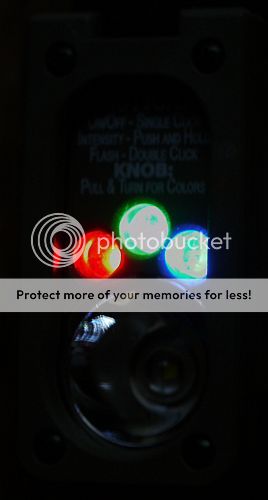
To change mode the rubber dome switch is held down to cycle through the modes and follows the sequence Max -> High -> Medium -> Low -> Medium -> High -> …… so unlike many lights it ramps up and down and does not jump straight from Max to low.
A quick double click enters the flashing mode which is set at Max output.
Surrounding the switch is a selector ring for the emitter. This must be pulled up, rotated and dropped back down to lock in the selection. The emitter can be changed while the light is in any mode without changing the mode. Two hands are needed to change the emitter and the selector ring has a raised section to allow for tactile LED changes.
Batteries and output:
Streamlight specify only alkaline or lithium AAs can be used. However three types of AA cell were compared; Ni-Mh, Alkaline and Lithium cells. The result was that the Sidewinder gave the same output on each of these on all levels. All further tests were carried out using Sanyo Eneloops.
To measure actual output, I built an integrating sphere. The sensor is a photo-diode restricted to visible light only (so Infra-Red and Ultra-Violet will not register). This was chosen as our eyes can only use the visible wavelengths of light so this is generally the only useful output. The integrating sphere was calibrated using 12 different reference sources and taking an average of the factor used to convert the measured voltage output to Lumens. Output figures are quoted as ANSI lumens where the measurement is made 30s after turning on the specified output level. Initial figures when first switching on are always higher, but all quoted measurements are ANSI.
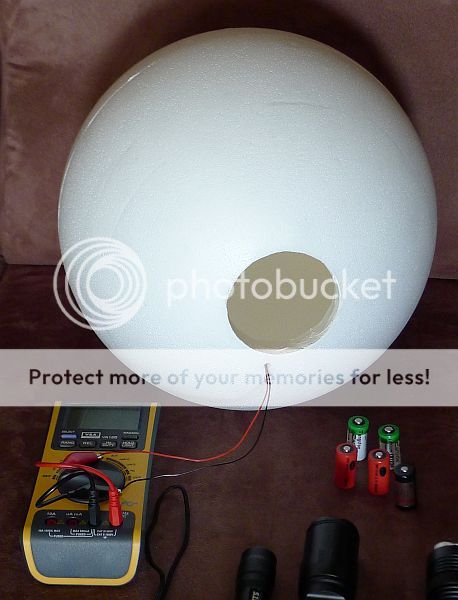
Please note, all quoted lumen figures are from a DIY integrating sphere, and although every effort is made to give as accurate a result as possible, they should be taken as an estimate only. The results can be used to compare outputs in this review and others I have published.
Output is regulated and as the batteries become depleted, the output drops a level. Once the lowest level is reached, eventually the Sidewinder will switch itself off. After a period of recovery, you will typically be able to squeeze a little more light out.
As the coloured LEDs run at much lower outputs, as shown in the table above (using blue as a typical example), once the Sidewinder can no longer output white light, you can switch to a coloured LED and run for several hours longer.
Being a soft click button, there is parasitic drain to be considered as the internal circuit is kept powered. The Sidewinder has an unprecedented 0.2 μA (yes, zero point 2 micro amps). This is the lowest I have ever come across, and would take 1140 years to drain the two eneloops!
In The Lab
In an attempt to quantify the actual beam profile I developed the following test. There are probably many flaws in my method, but it is simple and easy to carry out and seems to provide a good enough comparison.
The method used was to support the light 1m off the floor and 1m from a wall, with a tape measure on the wall. The zero of the scale is placed in the centre of the hotspot and a lux meter is then positioned at points along the scale, with the measurements recorded. Beam shots are often taken with the light shining on a flat white wall, so this method is simply measuring the actual intensity across the beam on a flat surface, not the spherical light emission.
The results are then plotted on a graph.
For the best throw you want to see a sharp peak with less of the distracting spill. For the best flood light the trace should be pretty flat.
The Sidewinder beam profile is shown here compared to the Sidewinder Compact II (which I am also reviewing). Though the sidewinder has a lower peak intensity, its beam is spread more, giving more light in the spill area.

Taking this a little further, I calculated an approximate factor to apply to the lux measurements, as each measurement gets further from the centre of the beam, it corresponds to a larger area onto which the light is falling. It seems to me that this should also be taken into consideration, so I applied these area corrections and came up with this odd looking graph.
The key quantity here is the area under the graph line. This should correspond to the total light output.
The extra light energy in the Sidewinder's spill is shown clearly here.
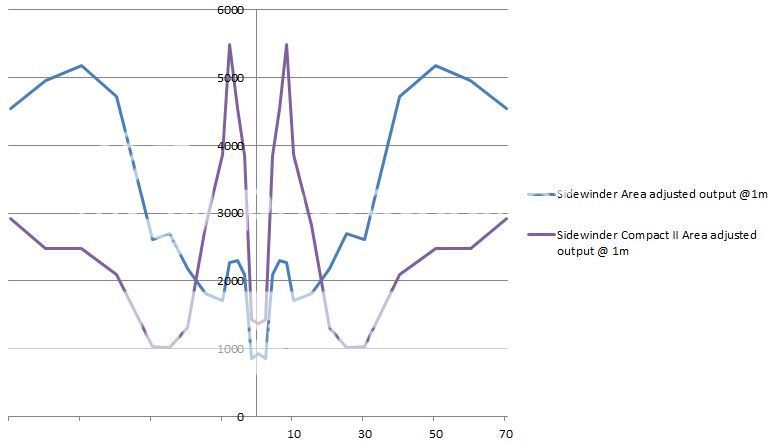
The beam
As shown by the previous beam profile graphs, the Sidewinder has a mix of throw and useful spill.
The beamshot is exposed to give an impression of the beam's brightness to the naked eye.

You can see some shaping of the spill due to the square front of the Sidewinder's casing.
Compared to many of the lights now on the market, the Sidewinder's beam is not the best. It does have some artefacts and is not perfectly even, but is perfectly usable.
Output from the 5mm LEDs is typical as far as beam quality goes.
What it is really like to use…

The recessed soft-click switch is deep enough not to activate accidentally, but not so deep as to make it difficult to operate.
The head angle adjustment means you can use the Sidewinder as a straight light, making it much like a standard light with a side switch. For general use this is much more ergonomic than a tail switch.
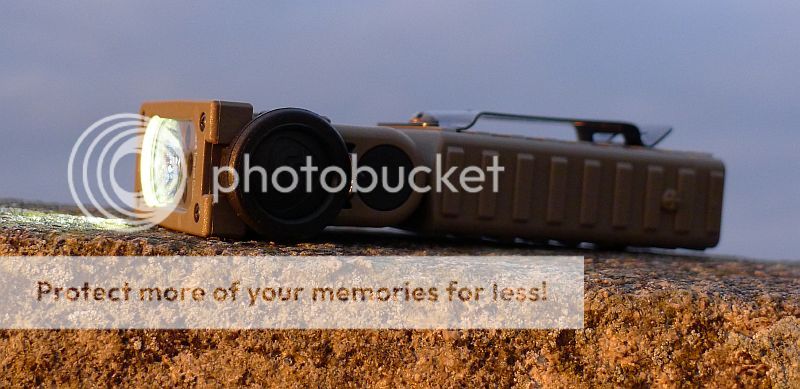
The maximum output is not that high, at a measured 66 lumens, but this is perfectly sufficient for dark environments up to many meters away. It may not be enough in high contrast situations such as peering into an engine bay on a sunny day, but when not fighting another source of light is a reasonable output level.
I've found myself making use of the adjustable head angle regularly. Tail-standing the Sidewinder and adjusting the head angle means you can aim the beam where you want it. You can clip the Sidewinder onto a baseball cap peak and use it as a head light.
The sportsman model on test comes on with the maximum output level. For general non-dark adapted eyes, this works very well. The military models come on with the low output, so you can buy the version that suits your requirements for coming on at low of maximum output.
Of course even with the sportsman model, if you need low, you can turn it on with the head pressed into your leg until you have set the output to low.
Having a choice of colours, for lower level specialist lighting needs is very useful. Around animals, or if going hunting, the non-white outputs can be less startling and better with dark adapted eyes.
So far, I've not needed to operate the light using the tactile features, but it is good to know that if necessary, I could change the batteries, and select one of the lower output coloured LEDs all by feel alone.
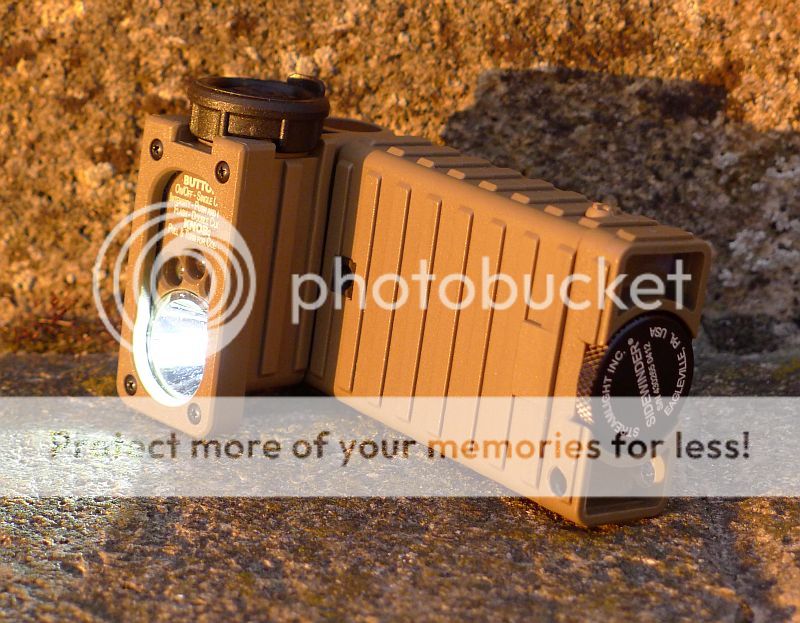
Despite not being the highest output, or using the latest LEDs, the Sidewinder has proven to be a really useful light. Well designed and made, you get great flexibility with four colours to choose from, each with four regulated output levels and a flashing mode.
A significant bonus is the fact that even once you can no longer get any output on the white LED, you can get several more hours on one of the coloured LEDs, so even if you don't have a change of batteries, you won't be left in the dark.
The Sidewinder is proof that it is not all about maximum output and perfect beams, with function and versatility being more important for general use.
Test sample provided for review by Streamlight.
I'll update post 2 of this thread once I have some more comments to add....

This is the first review of this series of four Streamlight lights and I'm starting with a distinctive light that has been around since 2007 (and updated in 2009 to the C4 LED), the Sidewinder.
Designed as a replacement for the older incandescent fixed right-angle military lights, the Sidewinder offers much more and is still relevant today.
The Sidewinder itself has three different versions each providing slightly different characteristics to fine tune the output to the individual user's requirements. On test is the Sportsman version.

Initial Impressions:
The Sidewinder really is something a bit different. Love or hate its looks, call it ugly, industrial, or functional, but its design serves its function perfectly.
We are used to multiple emitters in lights these days, but usually to boost output; the Sidewinder uses four different emitters to give the user 20 different colour/brightness output options in one light.
Despite not looking ergonomically designed, the Sidewinder handles very well and is comfortable to use. Its adjustable angle head makes it possible to use the light in many different ways from a standard light to a MOLLE-mounted right-angle light.
What is in the box:
The Sidewinder comes in the blister-pack type of packaging.


It is simply supplied with an instruction manual and two Energizer Alkaline AA batteries.

Taking a closer look and looking inside:
Viewed from the front, with the head set in the 90° position shows the Sidewinders polycarbonate lens and the four emitters.

The head moves a total of 185° and is shown here straightened to make the Sidewinder more like a traditional light. Near to the head joint you can see the alternate fixing point for the clip. This allows you to choose which side to have the clip on depending on how you hold it and want to operate the switch.

As supplied the clip position seems to suit right-handed users. The clip is sturdy, and made of coated steel. IT allows for belt, MOLLE, and with the ACH mount, helmet mounting options.

Looking more closely at the LEDs, the white emitter is Streamlight's C4 emitter (though C4 seems to cover many different LEDs) and the three standard 5mm coloured LEDs, red and blue either side of the green. The green LED is an infra-red LED on the military version.

The tailcap is secured with a metal thumb screw and is flat, allowing tail-standing and it will tail-stand even with the head at 90°.

In line with its military design, the tailcap is captive, being secured by a metal wire tether.

Looking down into the Sidewinder shows the contact design, which prevents problems caused by the batteries being inserted incorrectly. The Sidewinder case has tactile raised dots to indicate the positive battery terminal position, so you can change batteries in the dark, by feel alone.

Shown with the white LED lit.

And here the raised positive terminal indicator can be seen on the top near the tail-cap.

Modes and User Interface:
"20 flashlights in one" is one of the claims made for this light. This refers to the set of five modes which are repeated for each of the four emitters.
Each emitter has Max, High, Medium, Low and Flashing modes available. For the Sportsman model on review, the Sidewinder turns on in Max and has red green and blue coloured LEDs.
Here the coloured LEDs are all shown on at once using a triple exposure for the photo, changing mode between exposures.

To change mode the rubber dome switch is held down to cycle through the modes and follows the sequence Max -> High -> Medium -> Low -> Medium -> High -> …… so unlike many lights it ramps up and down and does not jump straight from Max to low.
A quick double click enters the flashing mode which is set at Max output.
Surrounding the switch is a selector ring for the emitter. This must be pulled up, rotated and dropped back down to lock in the selection. The emitter can be changed while the light is in any mode without changing the mode. Two hands are needed to change the emitter and the selector ring has a raised section to allow for tactile LED changes.
Batteries and output:
Streamlight specify only alkaline or lithium AAs can be used. However three types of AA cell were compared; Ni-Mh, Alkaline and Lithium cells. The result was that the Sidewinder gave the same output on each of these on all levels. All further tests were carried out using Sanyo Eneloops.
To measure actual output, I built an integrating sphere. The sensor is a photo-diode restricted to visible light only (so Infra-Red and Ultra-Violet will not register). This was chosen as our eyes can only use the visible wavelengths of light so this is generally the only useful output. The integrating sphere was calibrated using 12 different reference sources and taking an average of the factor used to convert the measured voltage output to Lumens. Output figures are quoted as ANSI lumens where the measurement is made 30s after turning on the specified output level. Initial figures when first switching on are always higher, but all quoted measurements are ANSI.

Please note, all quoted lumen figures are from a DIY integrating sphere, and although every effort is made to give as accurate a result as possible, they should be taken as an estimate only. The results can be used to compare outputs in this review and others I have published.
| Sidewinder – Sportsman | I.S. measured ANSI output Lumens | PWM frequency (Hz) |
|---|---|---|
| White - Max | 66 | N/A |
| White - High | 35 | N/A |
| White - Med | 10 | N/A |
| White - Low | 3 | N/A |
| Blue - Max | 7 | N/A |
| Blue - High | 3 | N/A |
| Blue - Med | 2 | N/A |
| Blue - Low | 1 | N/A |
Output is regulated and as the batteries become depleted, the output drops a level. Once the lowest level is reached, eventually the Sidewinder will switch itself off. After a period of recovery, you will typically be able to squeeze a little more light out.
As the coloured LEDs run at much lower outputs, as shown in the table above (using blue as a typical example), once the Sidewinder can no longer output white light, you can switch to a coloured LED and run for several hours longer.
Being a soft click button, there is parasitic drain to be considered as the internal circuit is kept powered. The Sidewinder has an unprecedented 0.2 μA (yes, zero point 2 micro amps). This is the lowest I have ever come across, and would take 1140 years to drain the two eneloops!
In The Lab
In an attempt to quantify the actual beam profile I developed the following test. There are probably many flaws in my method, but it is simple and easy to carry out and seems to provide a good enough comparison.
The method used was to support the light 1m off the floor and 1m from a wall, with a tape measure on the wall. The zero of the scale is placed in the centre of the hotspot and a lux meter is then positioned at points along the scale, with the measurements recorded. Beam shots are often taken with the light shining on a flat white wall, so this method is simply measuring the actual intensity across the beam on a flat surface, not the spherical light emission.
The results are then plotted on a graph.
For the best throw you want to see a sharp peak with less of the distracting spill. For the best flood light the trace should be pretty flat.
The Sidewinder beam profile is shown here compared to the Sidewinder Compact II (which I am also reviewing). Though the sidewinder has a lower peak intensity, its beam is spread more, giving more light in the spill area.

Taking this a little further, I calculated an approximate factor to apply to the lux measurements, as each measurement gets further from the centre of the beam, it corresponds to a larger area onto which the light is falling. It seems to me that this should also be taken into consideration, so I applied these area corrections and came up with this odd looking graph.
The key quantity here is the area under the graph line. This should correspond to the total light output.
The extra light energy in the Sidewinder's spill is shown clearly here.

The beam
As shown by the previous beam profile graphs, the Sidewinder has a mix of throw and useful spill.
The beamshot is exposed to give an impression of the beam's brightness to the naked eye.

You can see some shaping of the spill due to the square front of the Sidewinder's casing.
Compared to many of the lights now on the market, the Sidewinder's beam is not the best. It does have some artefacts and is not perfectly even, but is perfectly usable.
Output from the 5mm LEDs is typical as far as beam quality goes.
What it is really like to use…

The recessed soft-click switch is deep enough not to activate accidentally, but not so deep as to make it difficult to operate.
The head angle adjustment means you can use the Sidewinder as a straight light, making it much like a standard light with a side switch. For general use this is much more ergonomic than a tail switch.

The maximum output is not that high, at a measured 66 lumens, but this is perfectly sufficient for dark environments up to many meters away. It may not be enough in high contrast situations such as peering into an engine bay on a sunny day, but when not fighting another source of light is a reasonable output level.
I've found myself making use of the adjustable head angle regularly. Tail-standing the Sidewinder and adjusting the head angle means you can aim the beam where you want it. You can clip the Sidewinder onto a baseball cap peak and use it as a head light.
The sportsman model on test comes on with the maximum output level. For general non-dark adapted eyes, this works very well. The military models come on with the low output, so you can buy the version that suits your requirements for coming on at low of maximum output.
Of course even with the sportsman model, if you need low, you can turn it on with the head pressed into your leg until you have set the output to low.
Having a choice of colours, for lower level specialist lighting needs is very useful. Around animals, or if going hunting, the non-white outputs can be less startling and better with dark adapted eyes.
So far, I've not needed to operate the light using the tactile features, but it is good to know that if necessary, I could change the batteries, and select one of the lower output coloured LEDs all by feel alone.

Despite not being the highest output, or using the latest LEDs, the Sidewinder has proven to be a really useful light. Well designed and made, you get great flexibility with four colours to choose from, each with four regulated output levels and a flashing mode.
A significant bonus is the fact that even once you can no longer get any output on the white LED, you can get several more hours on one of the coloured LEDs, so even if you don't have a change of batteries, you won't be left in the dark.
The Sidewinder is proof that it is not all about maximum output and perfect beams, with function and versatility being more important for general use.
Test sample provided for review by Streamlight.
I'll update post 2 of this thread once I have some more comments to add....

If you enjoyed my reviews, please remember to 'Like' me on Facebook and follow me on Twitter @Subwoofer_CPF
to get all the latest updates and news.
You can also find exclusive insights on Instagram and Pinterest





to get all the latest updates and news.
You can also find exclusive insights on Instagram and Pinterest

Last edited:

